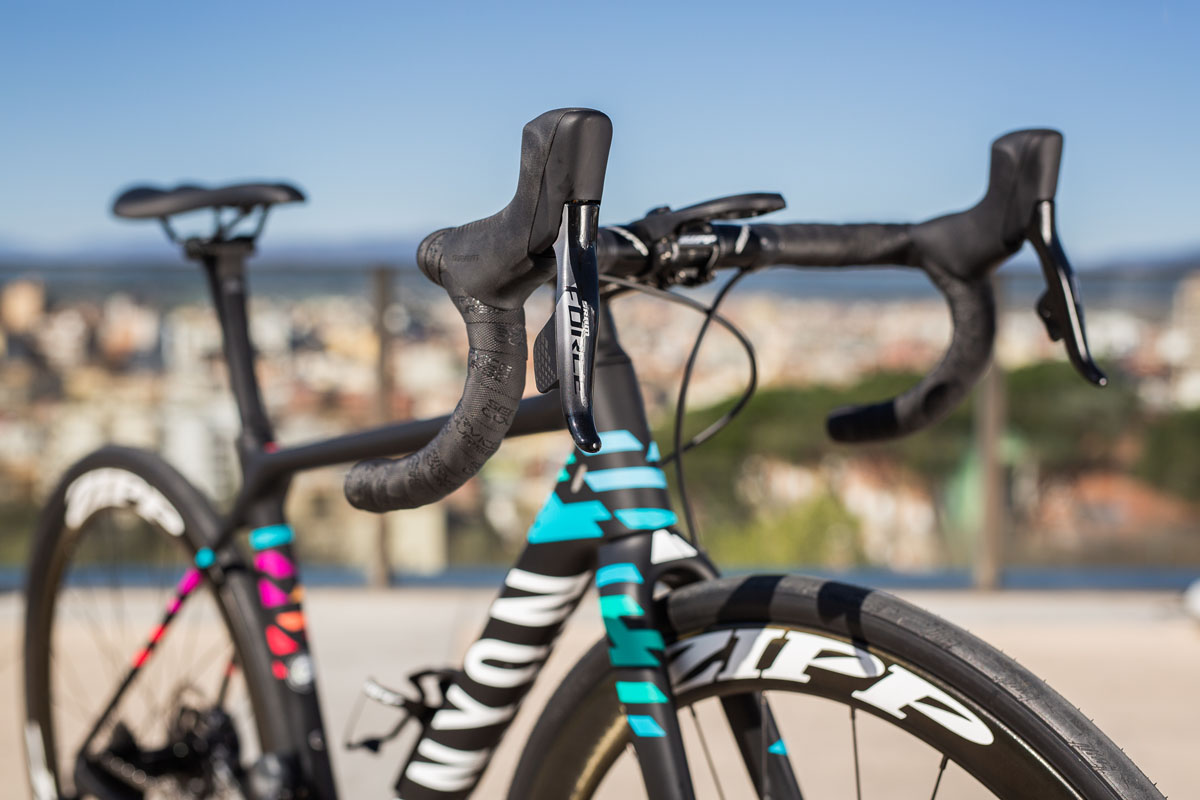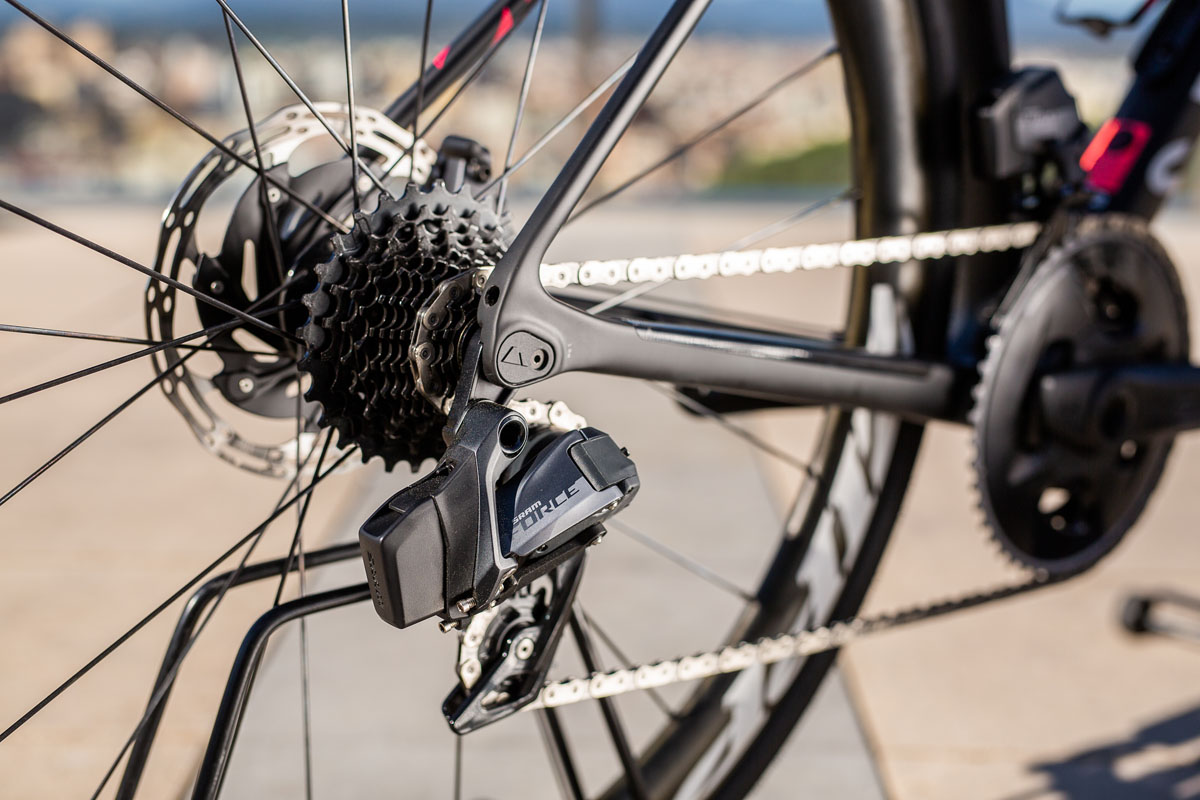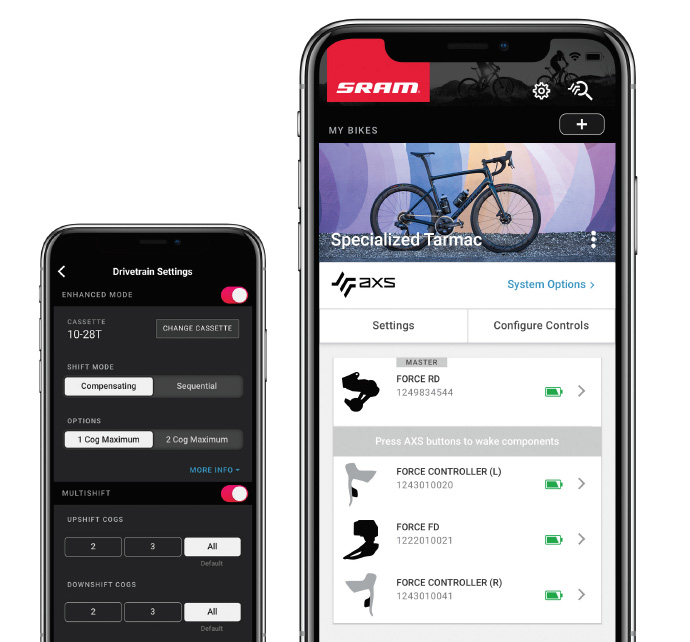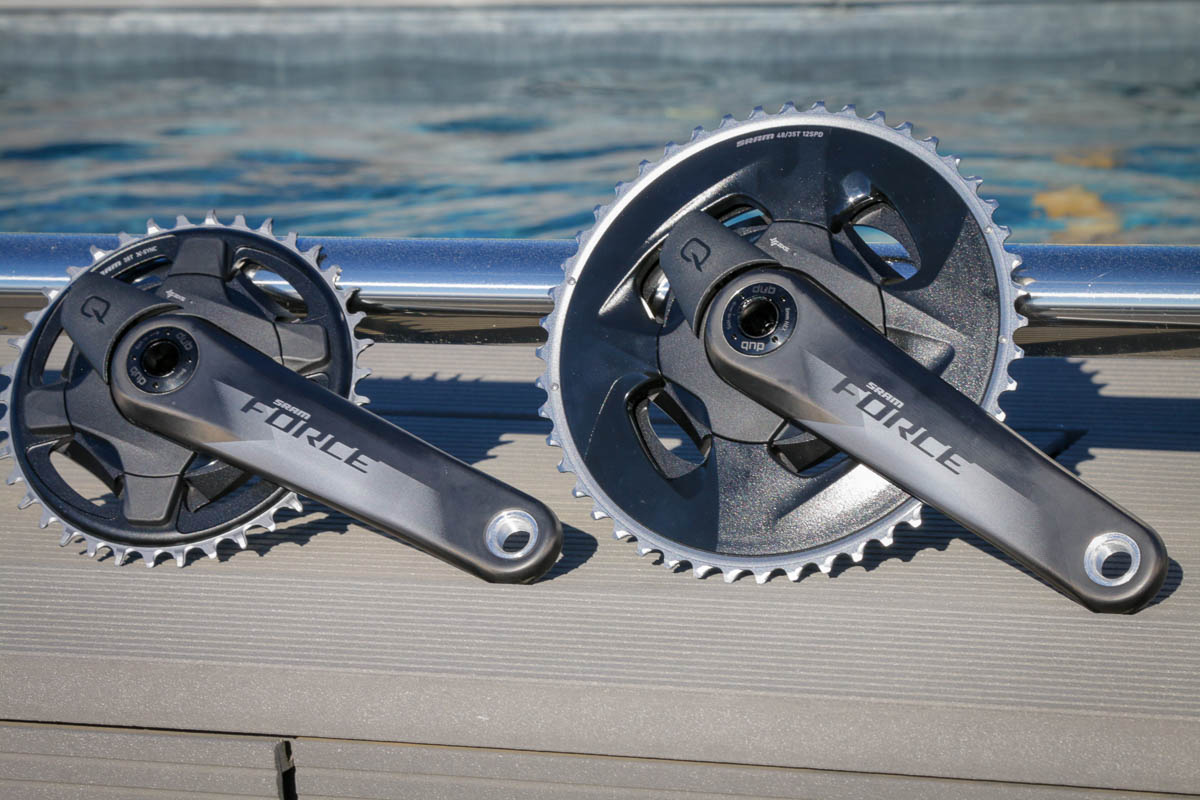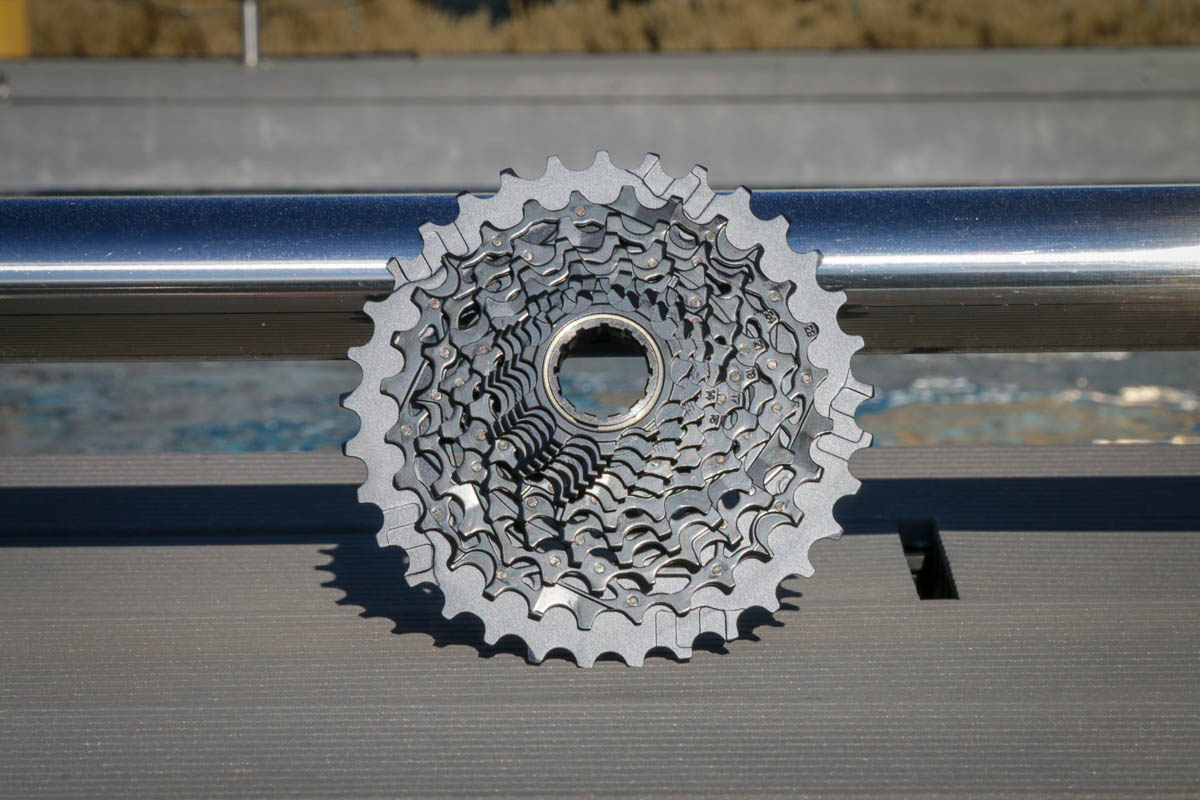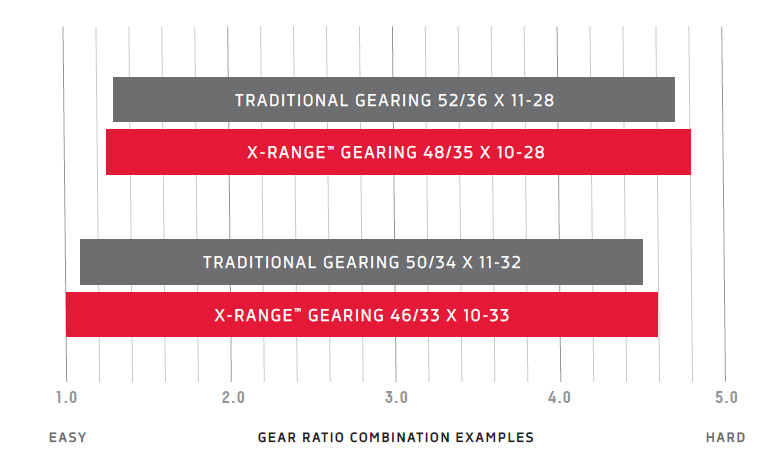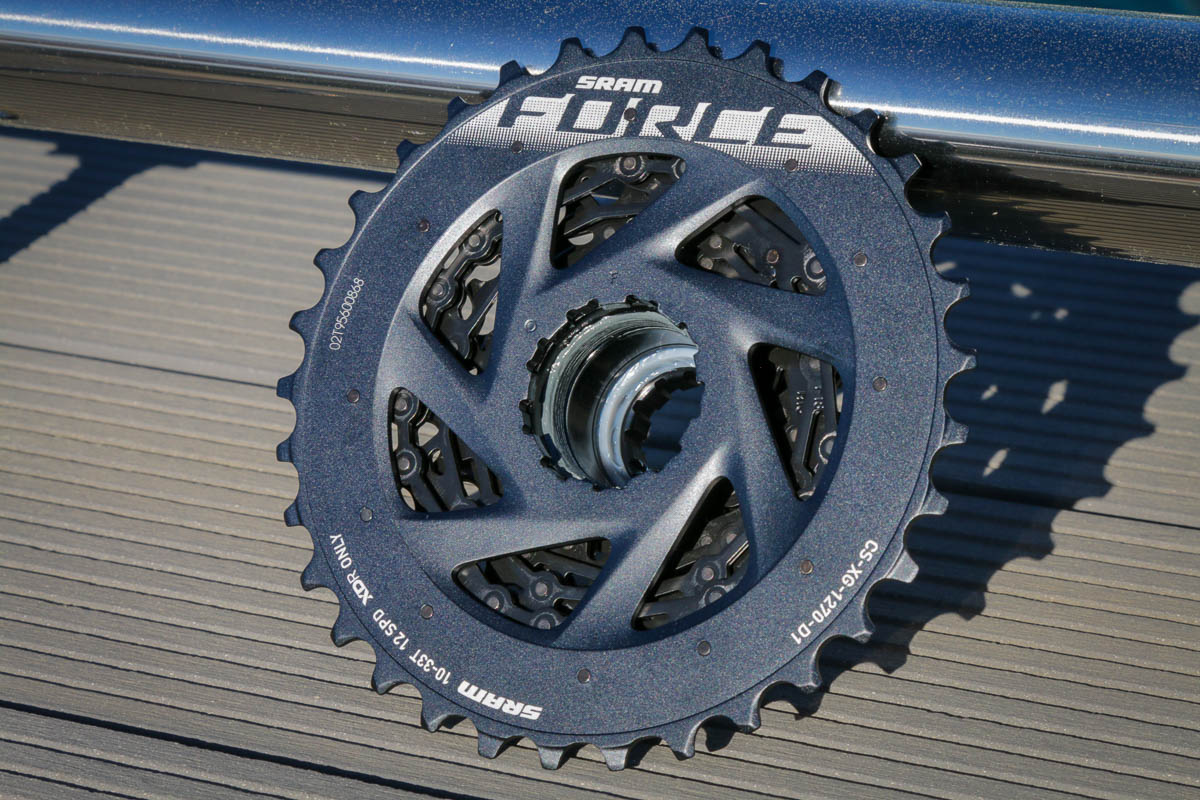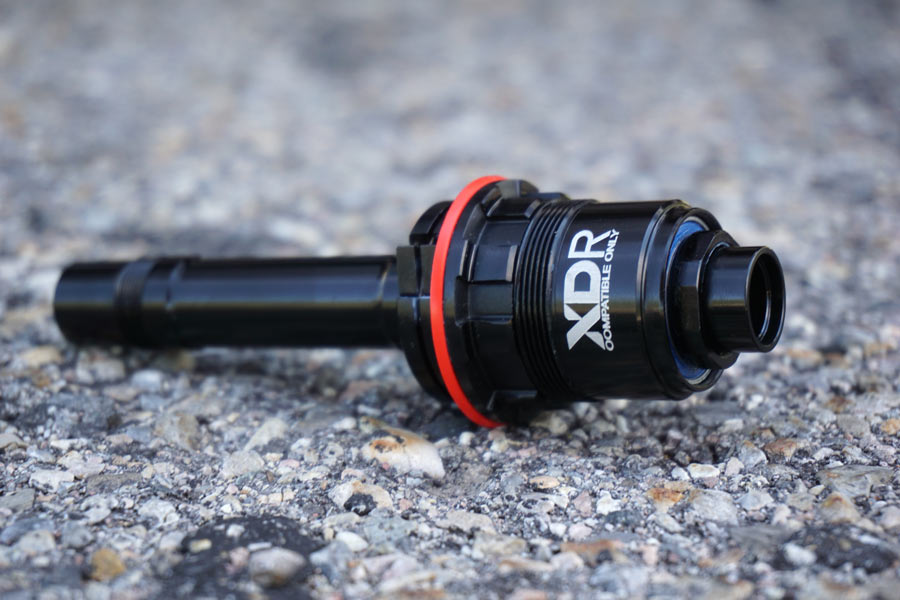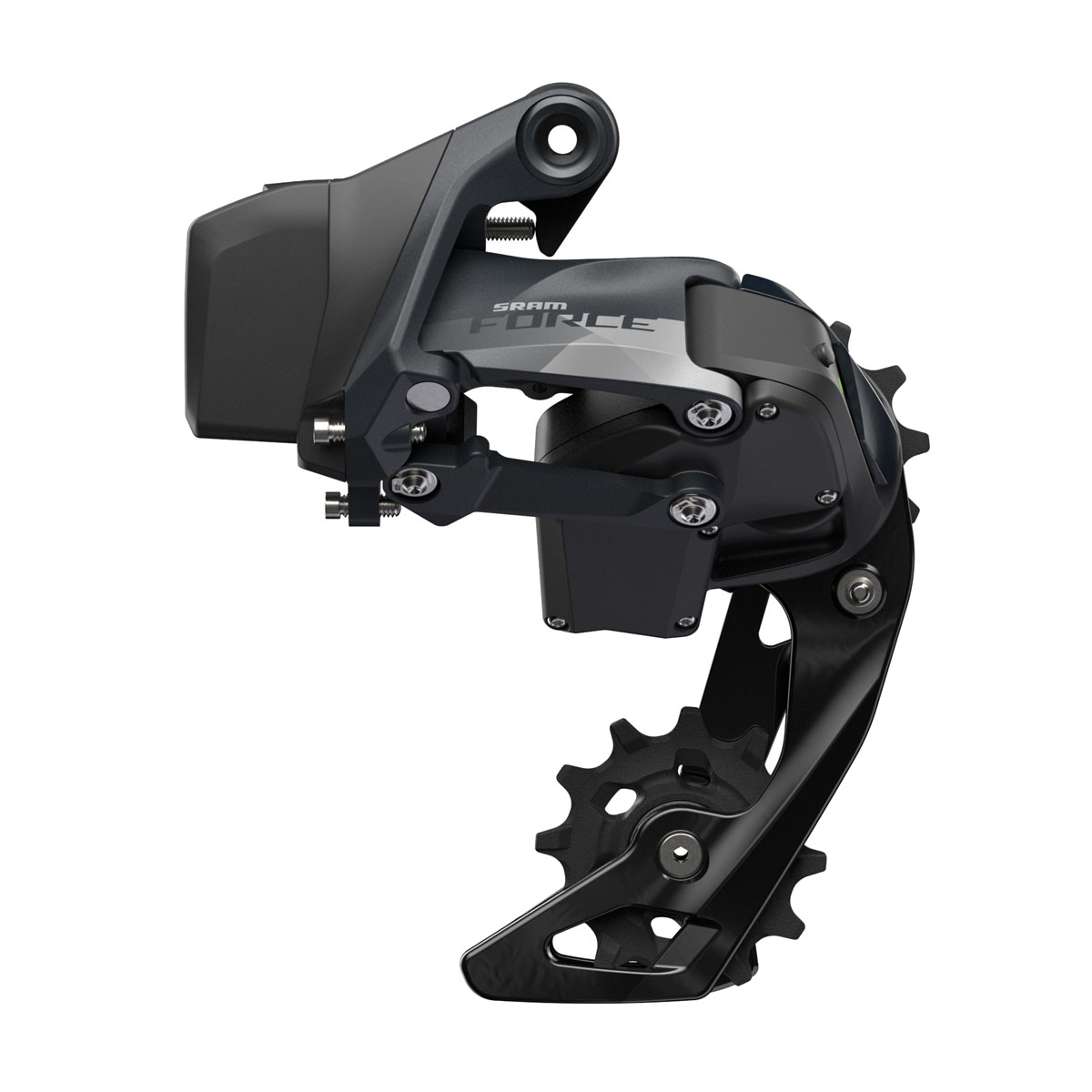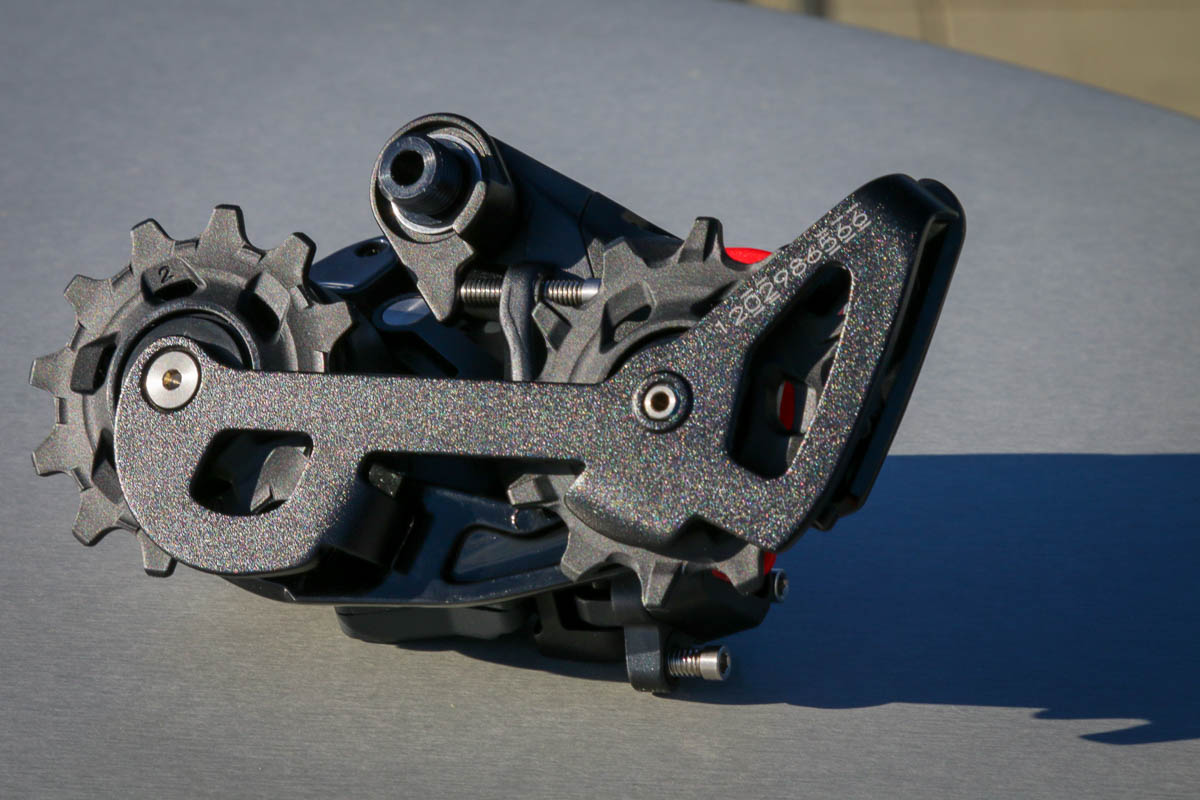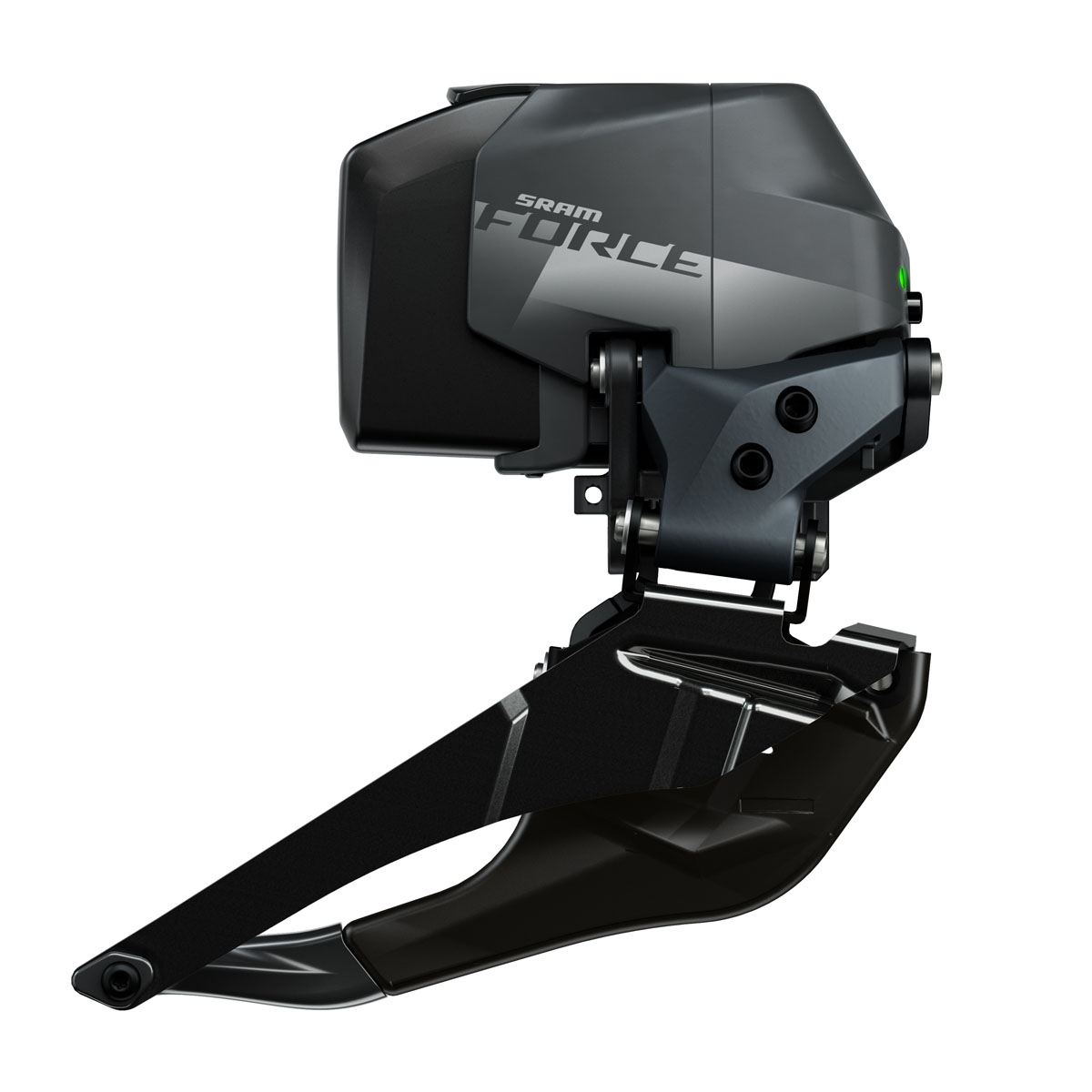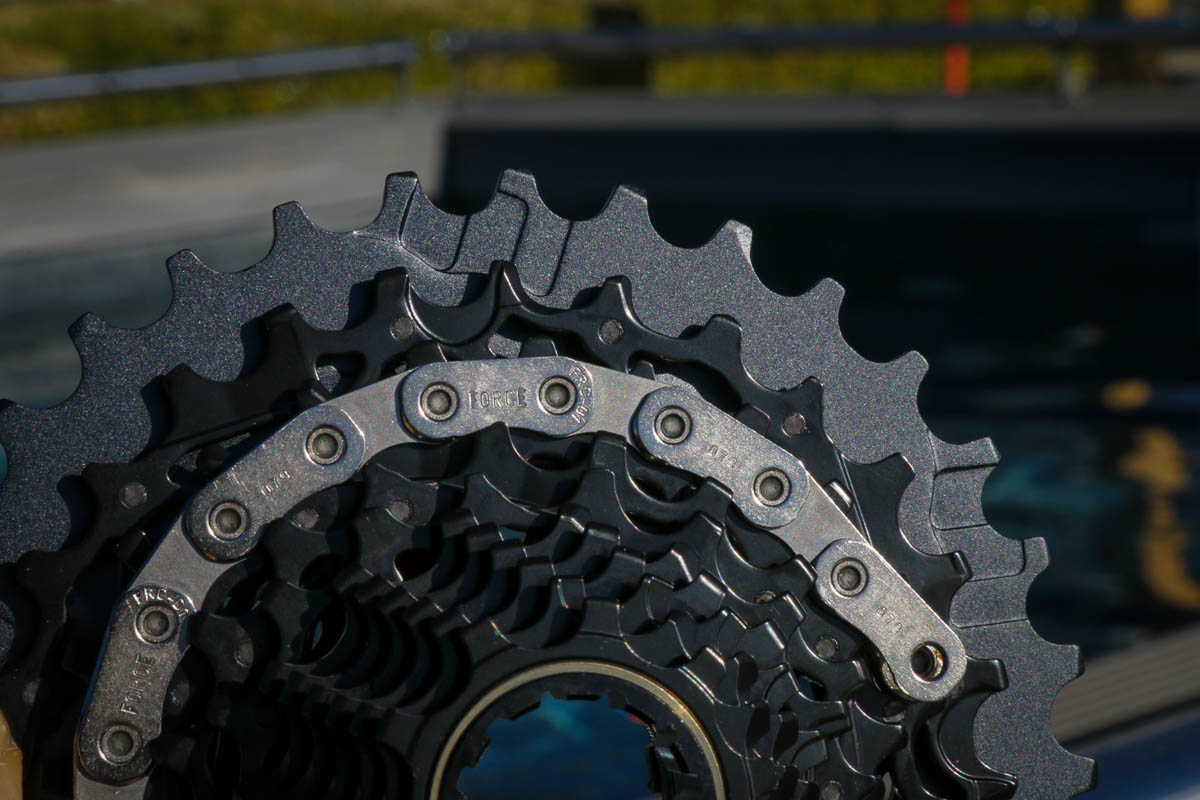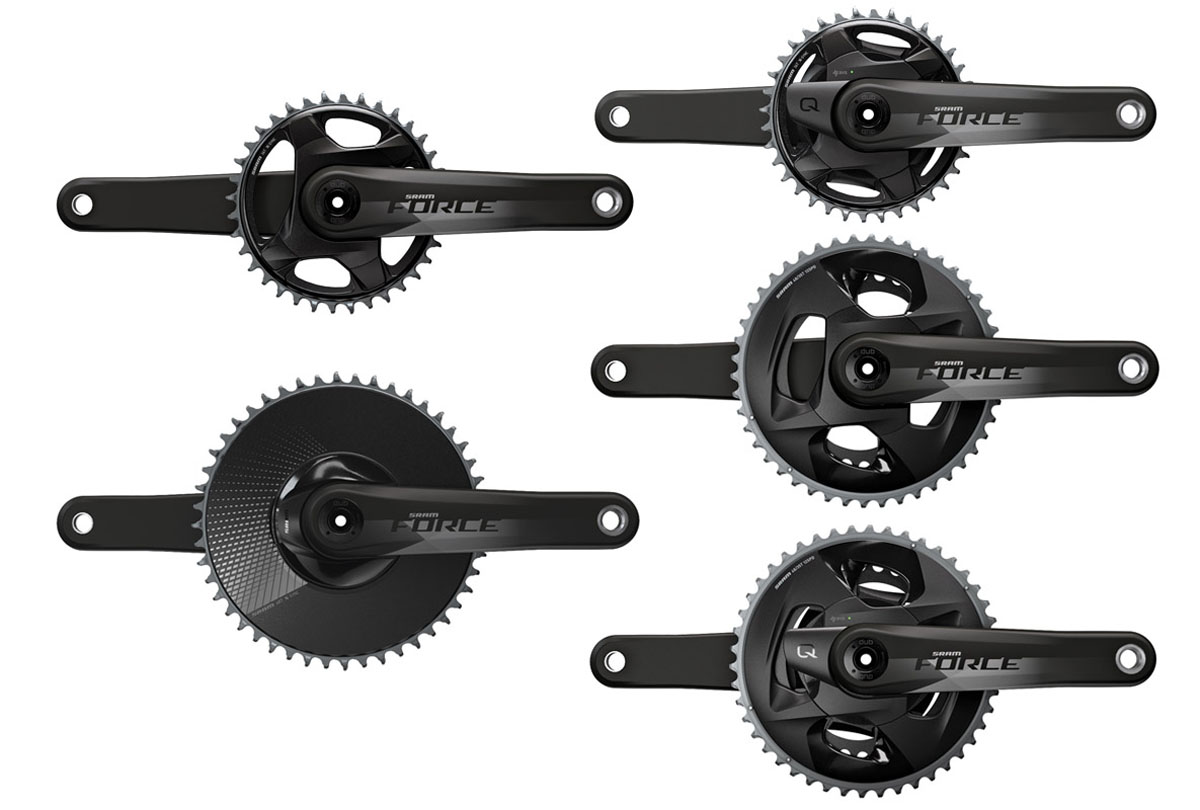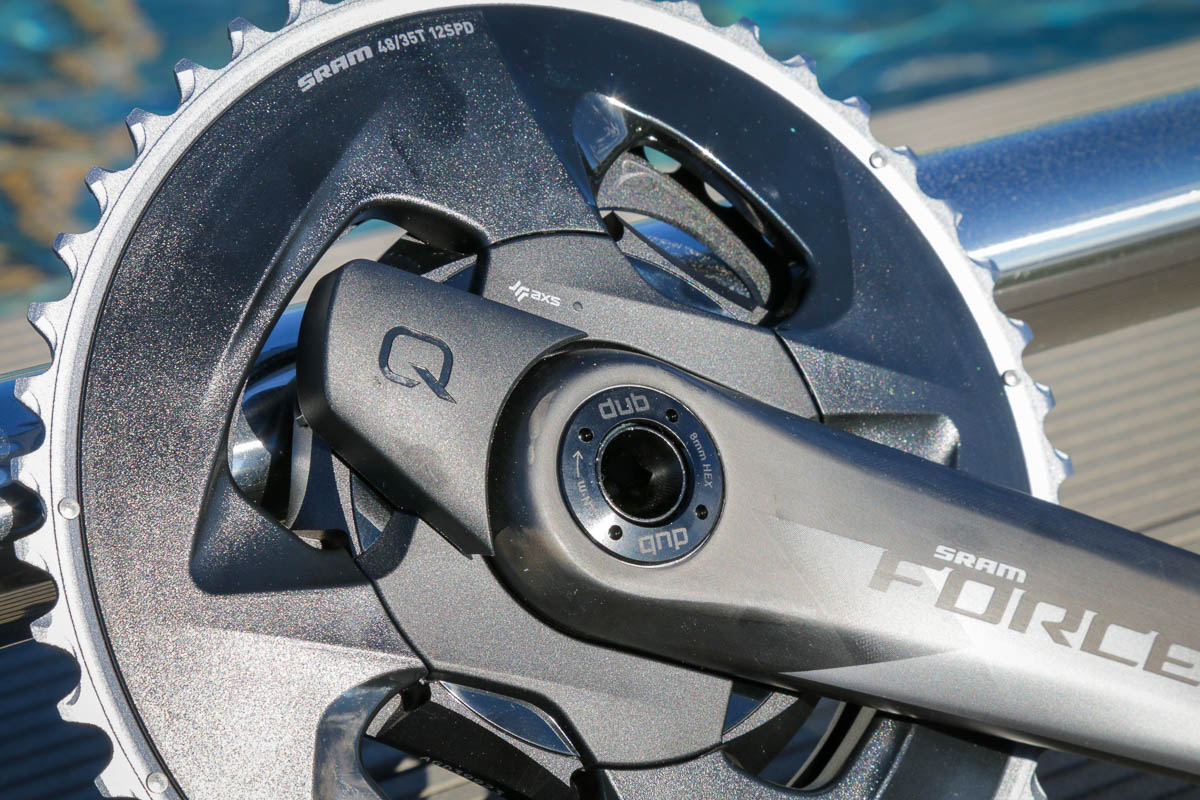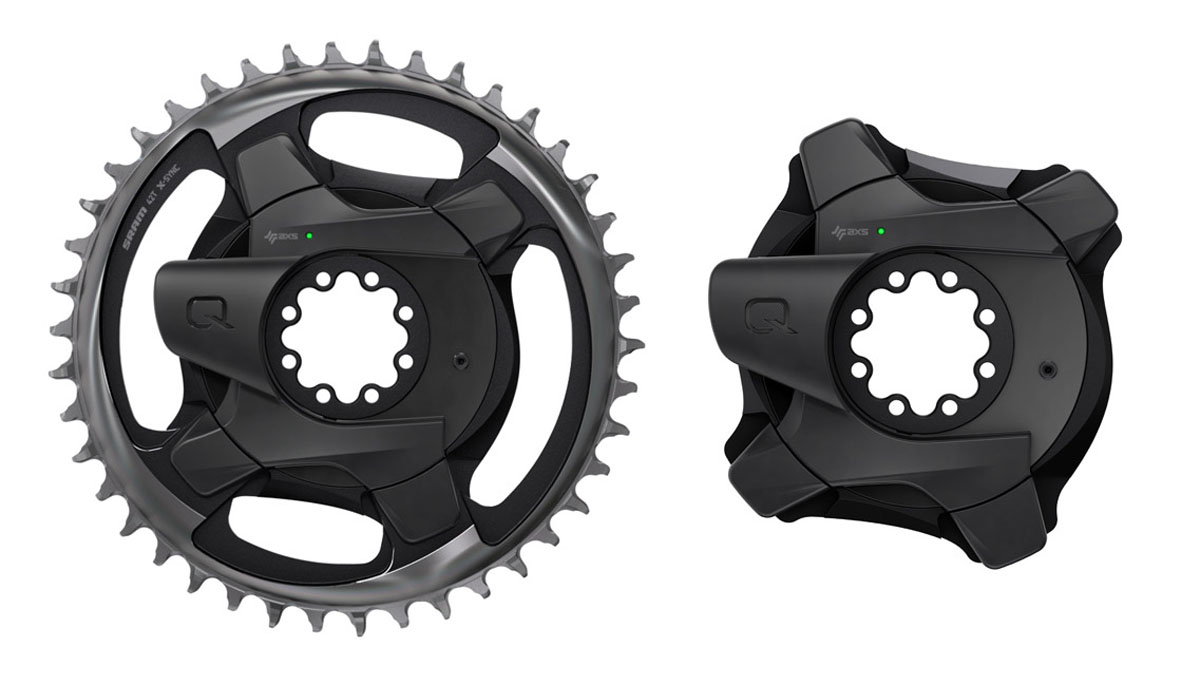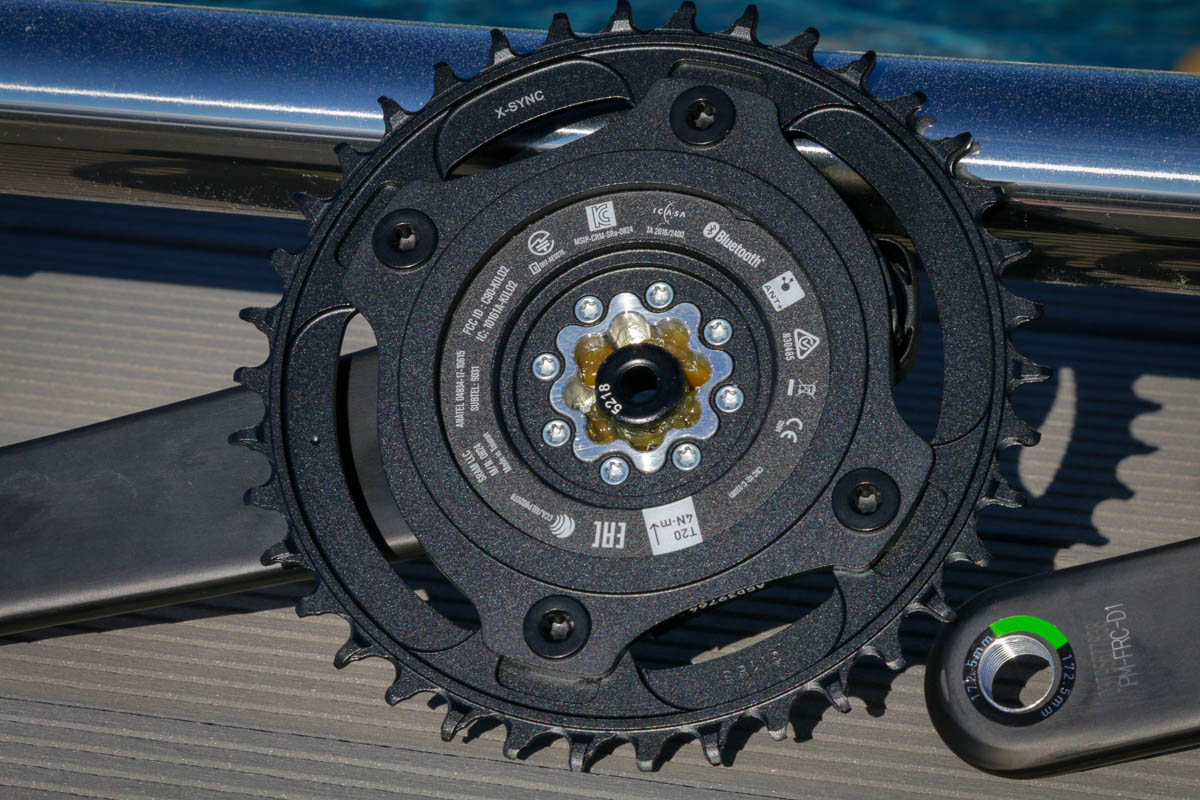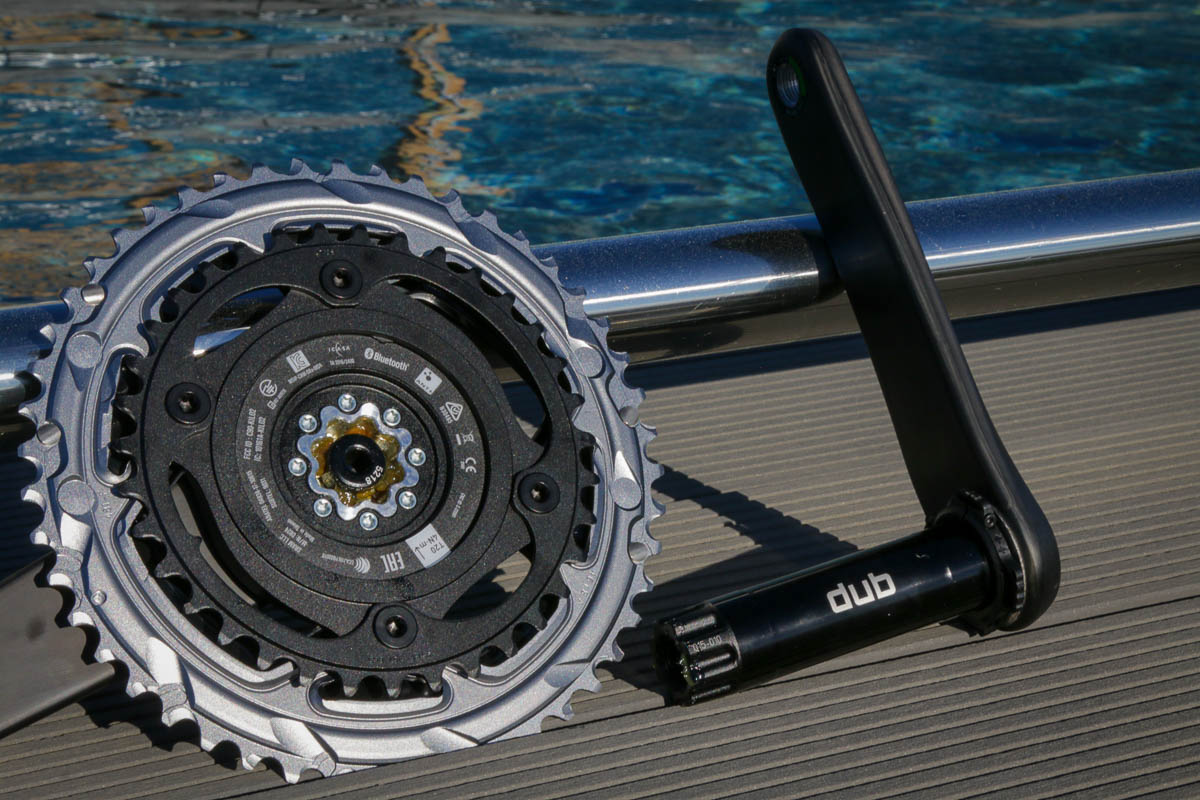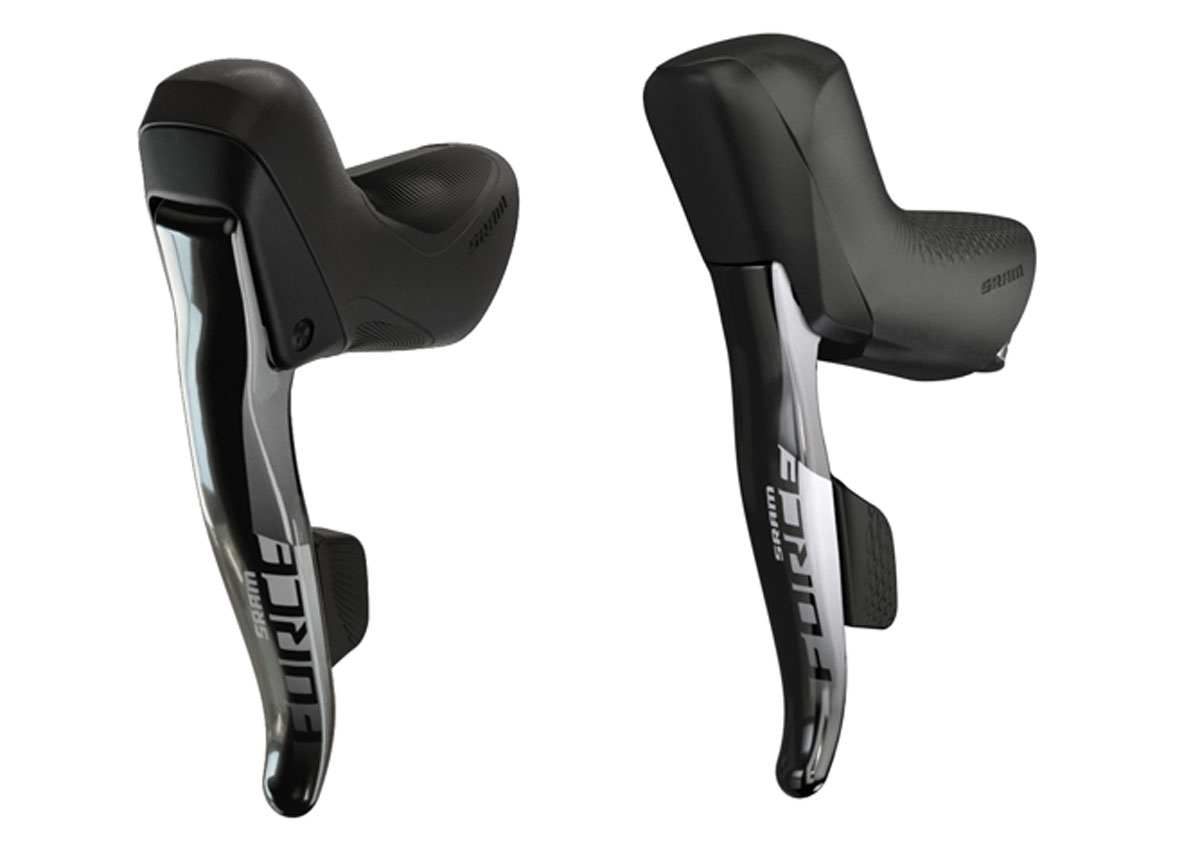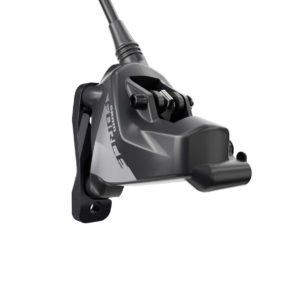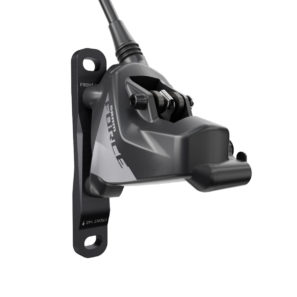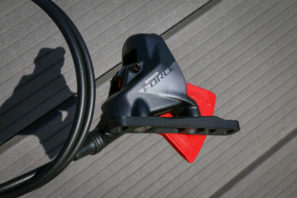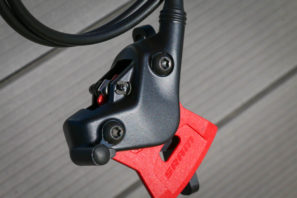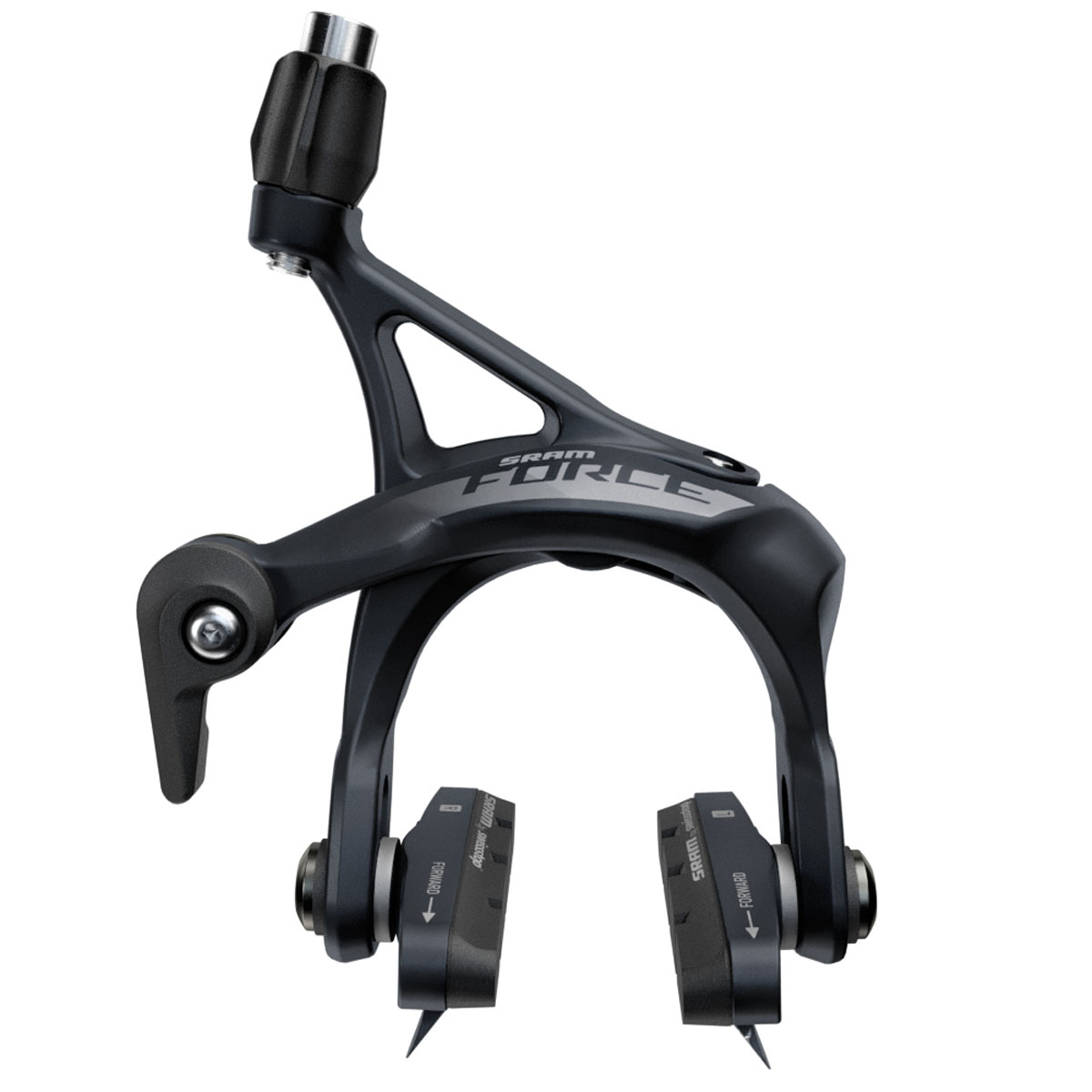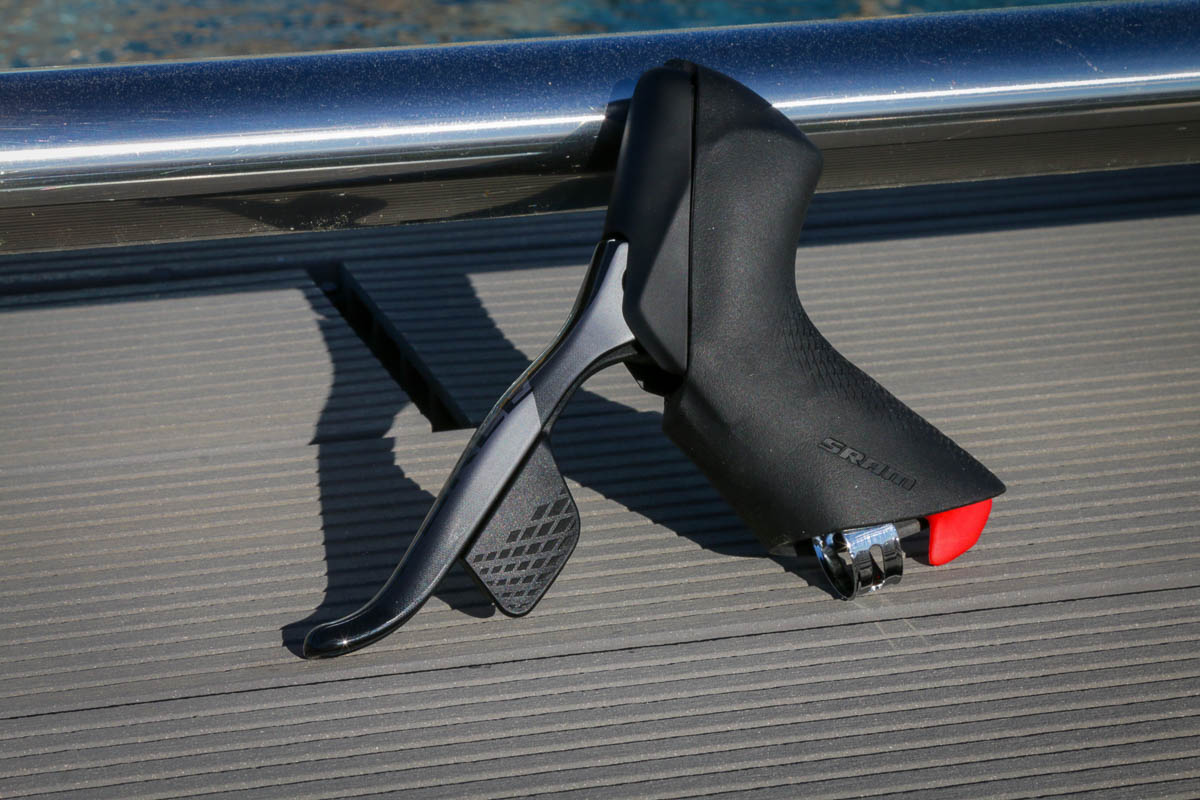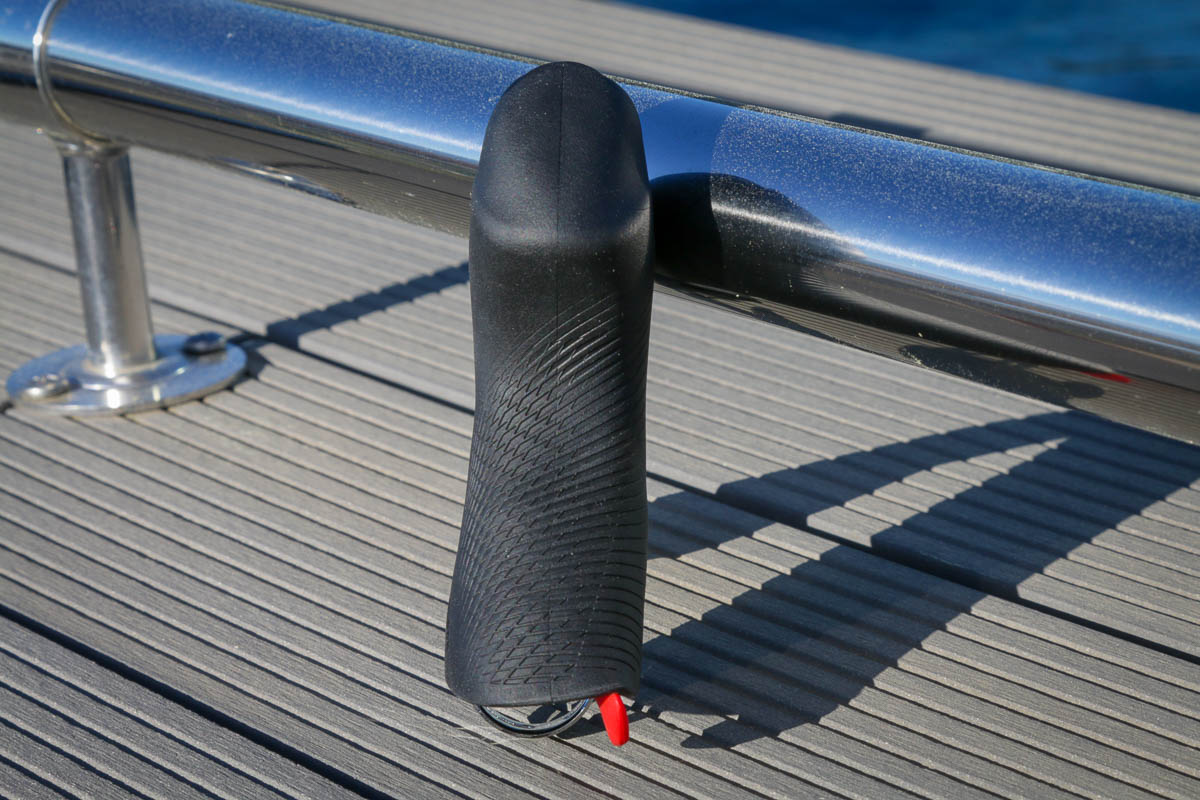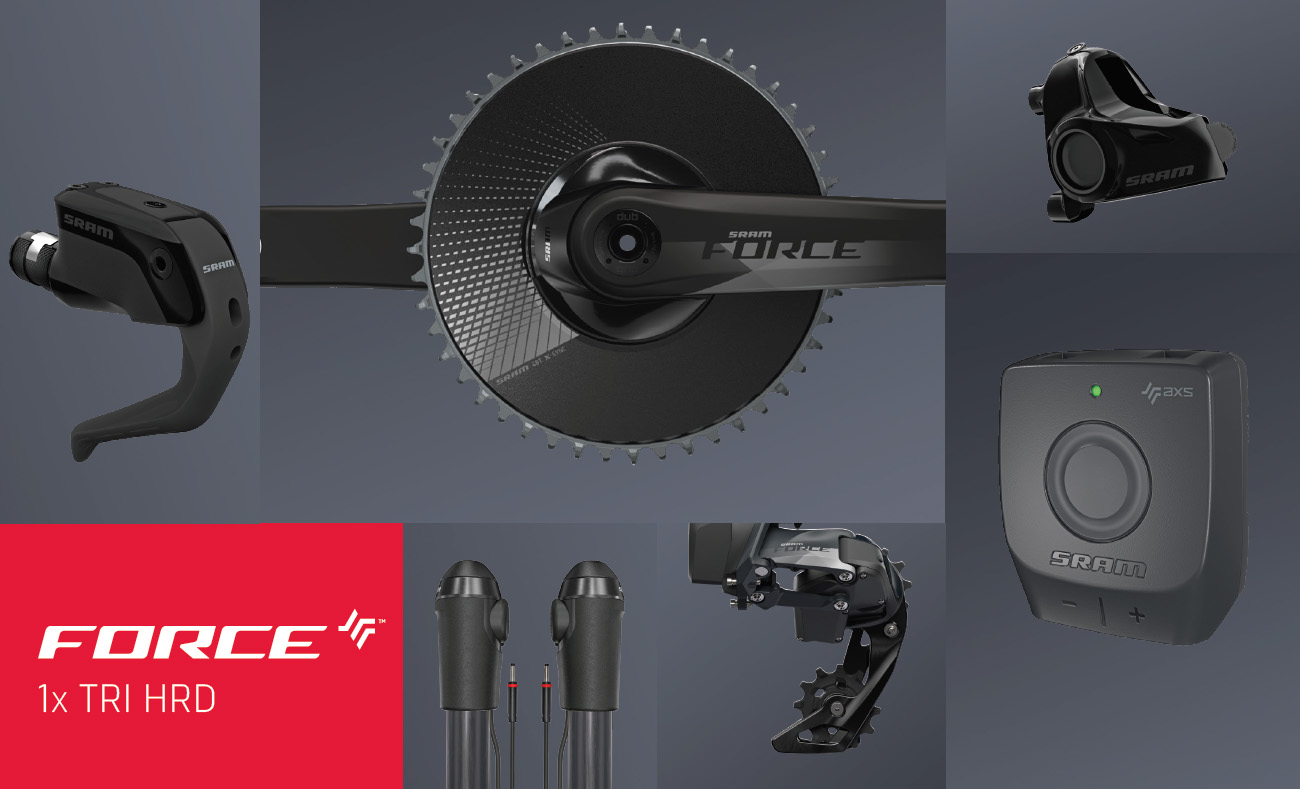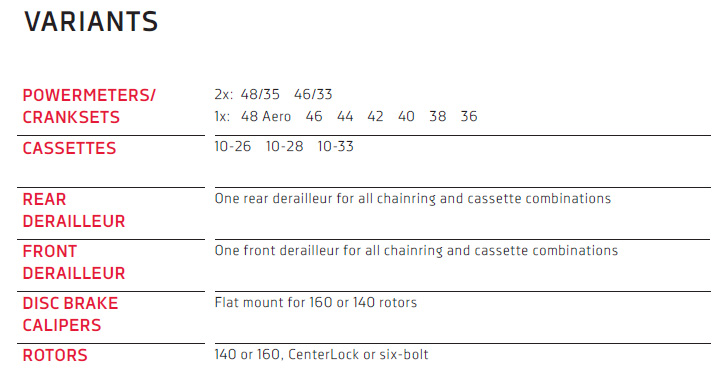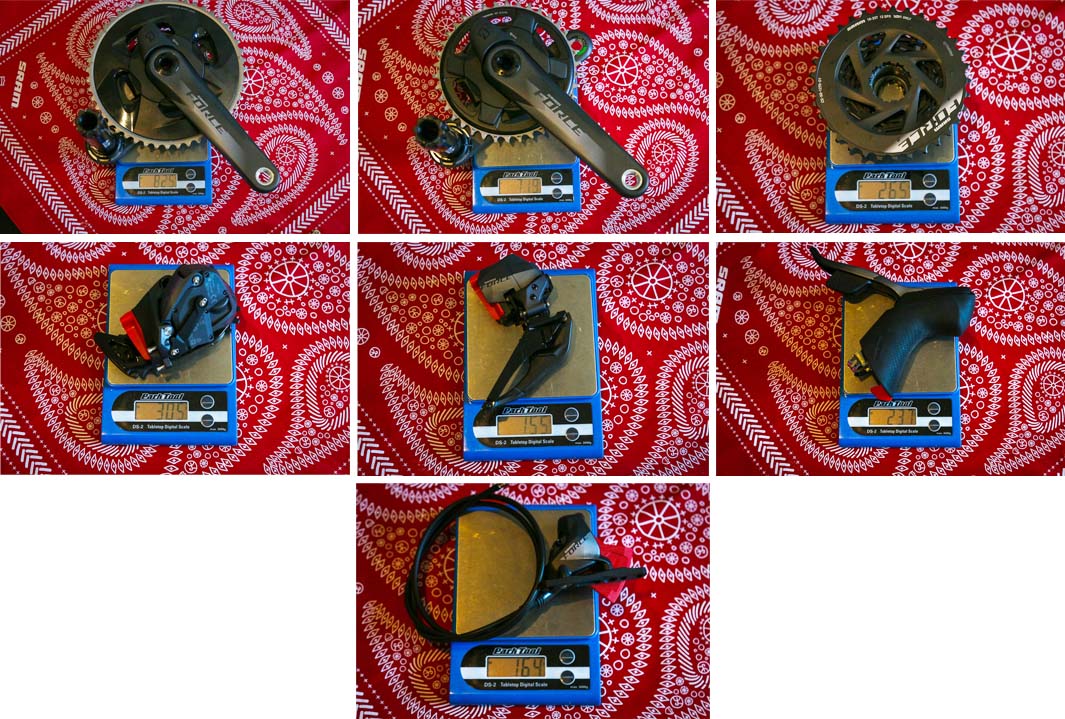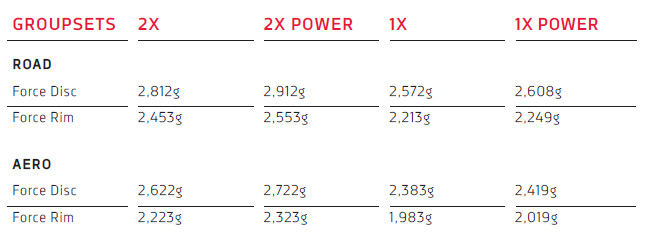SRAM has clearly been busy. Less than two months after launching the new RED eTap AXS group to the world, they’re already onto the next. That of course being the new SRAM Force eTap AXS group. As is often the case, the group is extremely similar to RED, but with some key differences that will be significant to many consumers – particularly when it comes to price.
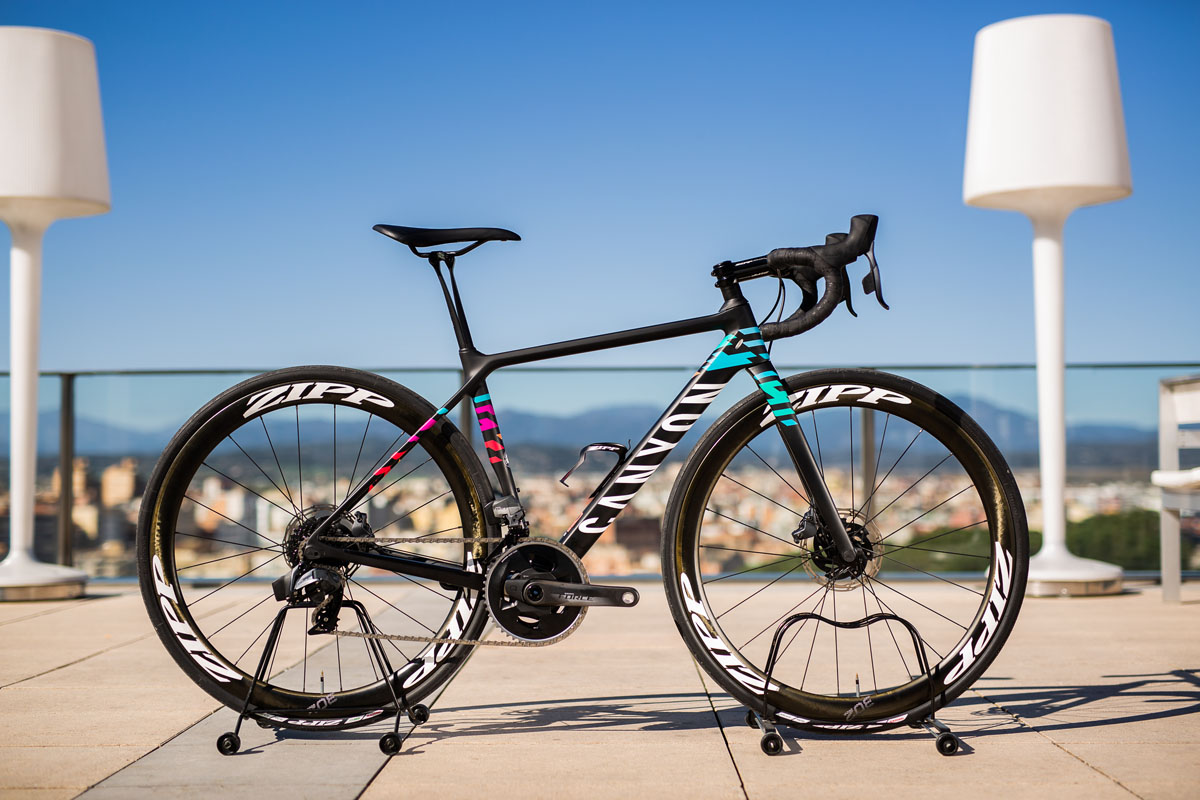
The newest member of the AXS (access) wireless family, SRAM Force eTap AXS is an electronic drivetrain with wireless shifting and options for either hydraulic disc or mechanical rim brakes. Other than a few very small details, Force is nearly identical in performance to the new RED AXS, with the main differences being materials, construction, and therefore weight. That means that the batteries are the same between the two groups (and older eTap groups as well) which is good news for teams or individuals with multiple bikes. Even the motors and chipsets are the same meaning the shift speed is identical between the two groups. Ultimately, Force ends up about 300g heavier than RED, but it’s also over $1000 less expensive which seems like a worthy trade off.

Force also has a completely different look which comes down to a difference in finishes. While forged aluminum parts can be polished to a beautiful shine, cast pieces can’t be polished – which requires a coat of paint. Overall, the finish on Force is less sophisticated which is where SRAM was able to drop some of the price.
AXS App
Like RED, Force is able to take advantage of the AXS app and component integration system which allows you to monitor and customize the performance of individual components. From checking each battery’s power level to customizing your shift patterns, updating firmware, and more, Force is joining the way of the app-based world.
Also like RED, this is a completely new group, so other than the mechanical rim brakes, none of the new parts will be compatible with older SRAM components – except of course the new SRAM RED eTap AXS. These two groups are completely interchangeable – which is good news for those who were upset by SRAM’s choice to integrate the power meter and chain ring on RED (but for a good reason, more on that below).
New gearing options just like RED… mostly
Following right along, gearing is also one of the biggest changes for SRAM Force. Yeah, they’ve gone to 12 speed in the rear, but as usual, it’s about more than just adding another gear. The new X-Range gearing ends up wider on both ends while the added cog results in better gear progression. The addition of the 10t cog allows for an increase in gear range without an increase in overall size of the drivetrain package with SRAM pointing out that smaller drivetrains will be lighter, less costly, and simpler overall.
In terms of chainring options, Force will see 48/35 and 46/33t double combinations with the largest 50/37t combination only available in RED. By moving to a 13t jump between chainrings, SRAM says this 20% reduction in jump size results in better shift quality and better front shifting overall.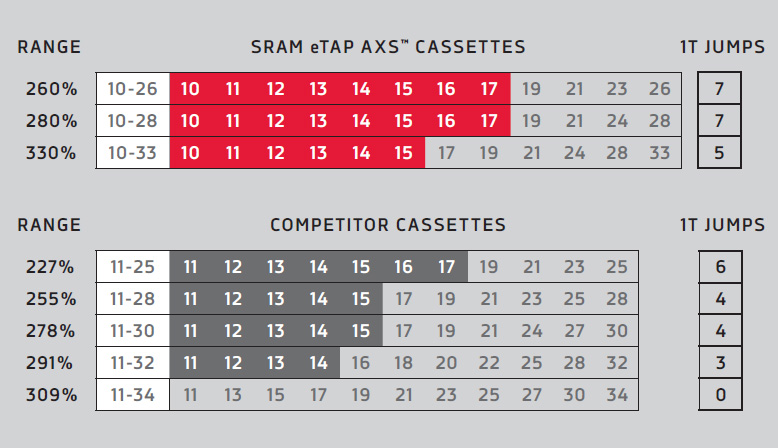
To keep the overall range, the rear cassettes move to a 10t at the small end, and up to 26, 28, or 33t as the largest cog with 260, 280, and 330% range respectively. Even the smallest cassette at 10-26 offers a wider range than an 11-28t. Moving the range from the front of the bike to the rear should mean you can stay in that current front chainring longer without having to shift. Obviously, if you’re running 1x, wider range in the rear is also a very good thing. The new cassettes also offer more single-tooth jumps between cogs for better shift progression when you’re moving through the gears.
Cassette options
In terms of construction, the XG-1270 cassette uses a Mini-cluster/Pin-Dome configuration with the first four cogs machined from a steel billet, and the remainder of the cassette using their Pin-Dome technology similar to their GX mountain bike cassettes. Looking at the cassette in profile, Pin-Dome makes more sense as you can see the pins that hold all of the steel cogs together after the first four cogs. The largest cog is aluminum which cuts down on weight and allows for a secure connection between the cassette and the freehub body that won’t dig into the new XDR drivers. The Mini-cluster/Pin-Dome cassette ends up about 50g heavier than a comparable RED cassette.
XDR Required
The addition of a 12 speed cassette meant that SRAM had to move to the XDR freehub standard like RED, which is just like XD, just 1.85mm longer. The added width is needed for the road since the largest cogs aren’t nearly as big as those on a MTB cassette and can’t be dished over the spokes. It also now matches up with the width of HG 11 speed freehub bodies for road.
Importantly, you can still run cassettes meant for XD freehubs on XDR freehubs with the addition of a 1.85mm spacer. You can’t however run cassettes meant for XDR freehubs on XD freehubs. SRAM points out that any Zipp wheels post April 2015 (176, 177, Super 9, and Cognition hubs) are XDR ready meaning you can add an XDR freehub. Also, the SRAM 900 hubset has included an XDR drive for awhile now – before you really needed it.
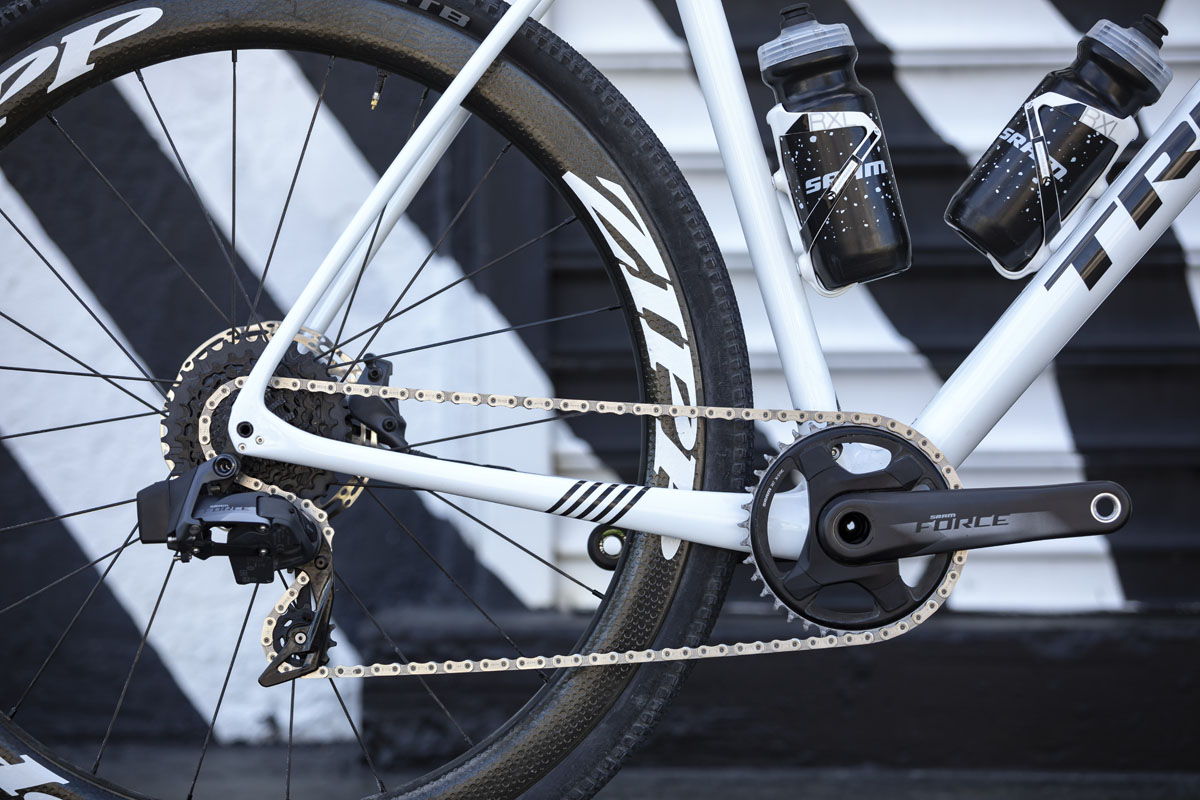
One Rear Derailleur to Rule them All
When it comes to choosing your drivetrain, you can run any cassette with any chainring combination all with the same rear derailleur – 1x or 2x. The new rear derailleur has been optimized to work with all of the cassette options in either chainring configuration and includes larger X-Sync pulleys with steel bearings, and the Orbit fluid damper in place of a mechanical clutch. Note that there is no longer a Cage Lock feature, but the Orbit damper works a bit differently and doesn’t really affect wheel changes. Compared to RED, the Force rear derailleur uses an aluminum derailleur cage instead of carbon, and steel hardware in place of titanium and aluminum.
Front Derailleur is Still There, and Better Than Ever
Up front, the new Force front derailleur is very similar to RED, but it swaps in a stamped steel derailleur cage for the CNC machined aluminum cage on RED. Riders who are pushing larger tires will be happy to hear that the derailleur has been streamlined to offer better tire clearance at the rear as well.
Force gets a Flattop
Completing the gearing is the new FRC-D1 Flattop chain. This new chain style is required for the group with SRAM stating that this chain represents their biggest investment in tooling on their part when it came to the new group. While it did get narrower to fit another cog, there is more to the story as usual. The shape of the chain is purely driven by their strength testing – the top of the chain never rides on a gear, so it can be shaped differently to provide increased strength.
Proportionately, the chain is also narrower to the cog spacing than a comparative 11 speed group which SRAM claims results in a quieter ride overall. The FRC-D1 chain is interchangeable with the SRAM RED chain, with the Force chain using solid pins as the only noticeable difference. Note that Flattop chains require a specific Flattop PowerLock. Also note that you definitely don’t want to run the new chain on 11 speed cassettes (think putting your bike on a direct drive trainer with an 11 speed cassette mounted). Apparently, the new chain will destroy the cassette, which is why companies like Wahoo are quickly working to add XDR driver capabilities to their trainers.
Acronym Glossary
If you haven’t already picked it up from RED, the new SRAM Force group comes with its own lingo, so here’s the breakdown:
-
AXS – Refers to the new digital family of wireless/electronic components that will all work together. Check our AXS overview story for everything you need to know on that. Basically, anything with the AXS logo can communicate with each other.
-
X-Range – The name for this entire new gearing concept.
-
Orbit Chain Management – A new fluid damper system that improves chain retention while still allowing for fast shifting.
-
AXS app – Lets you customize the setup and integrate cross-category components, check riding time, battery level, how many times you’ve shifted, and when you’re due for service.
-
FlatTop – The new, narrower chain that’s also stronger, quieter and more durable. It’s not backwards compatible (nor is any other component), everything here is designed as a system to maximize performance.
SRAM Force Cranks
With the launch of RED AXS, one of the things that seemed to catch everybody’s attention was the decision to integrate the power meter into the chainring. Yes, this means that when the chainring is dead, so is your power meter. But SRAM stands by the design, and here’s why: SRAM RED is meant to be the highest tier group for pro racers and consumers willing to pay top dollar in exchange for the lightest system possible.
The integration of the power meter into the chainring meant that SRAM could add power to the same crankset at a weight penalty of just 36g. It also ends up with a more accurate power reading because you’ve eliminated one of the connections at the spider/chainring interface. SRAM also claims that the new drivetrain offers much longer chainring and component life than previous groups, with field testing showing a whopping 2-4x increase in longevity – so it should take you much longer to wear out those rings.
Is it wasteful to create a one-time use power meter/chainring? Sort of. But that all depends if you take advantage of the SRAM support program where they take your old power meter/chainring back and recycle it while providing a new one to you supposedly at or near the cost of standard chainrings. That integrated power meter/chainring is starting to sound a lot better all of a sudden.
Change your rings without changing your power meter
BUT… what if none of that matters and you simply want to run power on your SRAM AXS crank without an integrated power meter/chainring?
You’re in luck. The Force chainrings and DZero power meter are not one piece, and the Force DZero power meter spider is compatible with SRAM RED crank arms using the same 8 bolt direct mount interface. That means if you buy a SRAM RED AXS crank with power and wear out the chainrings super fast (or just want to upgrade a non-power model), you can purchase a Force power meter spider and the Force AXS asymmetric 107 BCD (same as RED 1x) chainrings to go with it. This also allows for mixing and matching 1x chainrings from the RED group or their aero 1x chainring for TT/Tri bikes.
SRAM Force cranks will be available with or without power meters in 1x or 2x configurations, both of which separate the chainring from the power meter.
Keeping in line with all of the new cranks from SRAM, the Force cranks will include a DUB spindle option, but they will still offer a GXP version for Trek’s BB90 frames, Pinarellos with Italian threaded BBs, and other frames that require it.
SRAM Force eTap AXS brake/shift levers
At the controls, Force eTap AXS is all about wireless shifting – though not necessarily about hydraulic brakes. For those keeping the rim brakes alive, the Force eTap AXS group will be available in two versions; wireless shifting with mechanical rim brakes, or wireless shifting with hydraulic disc brakes.
The hydraulic option uses their Hydro HC platform specifically developed for eTap which means these brake calipers are different than those found on Force 1. The Force group uses a two piece caliper design with steel hardware, and the same brake pad as RED. Also, the Force brakes are flat mount only. Still running a post mount frame? The RED brakes are available in post mount as well as flat mount.
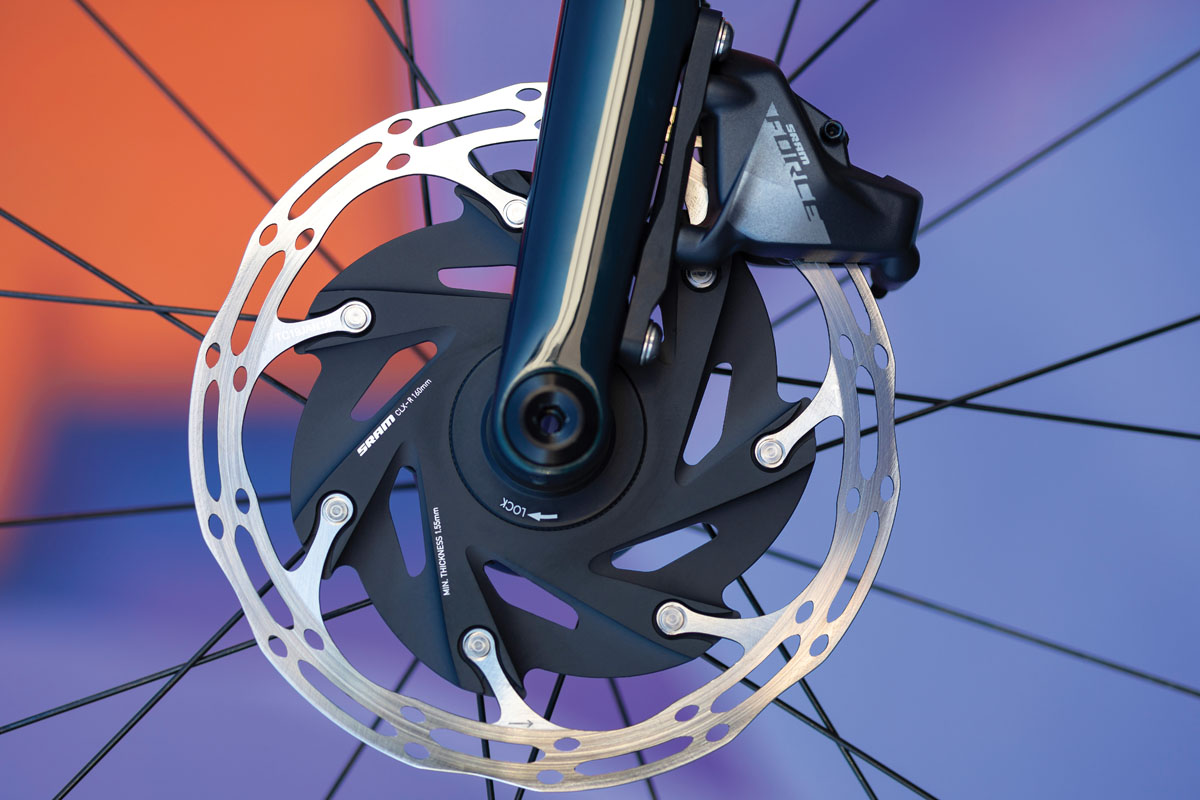
SRAM’s new Centerline XR (CLX-R) rotors are a thing of beauty and are the same rotors that you’ll find with SRAM Red. The rotors use an aluminum carrier and a steel CenterLine braking surface with rounded edges to be UCI-Compliant.
Rim Brakes Still Stop
The new Force group even includes a new mechanical rim brake if you are retrofitting an older bike or just don’t want to switch to disc. The brakes use a dual pivot design that is updated to fit wider rims and tires (up to 28mm), and include Swissstop Platinum Flash Pro pads for carbon or BHP pads for aluminum rims.
Offering independent reach and contact point adjustment, the levers are nearly identical to RED other than they have just one Blip port rather than two on each shifter. You’ll also find a composite lever blade rather than true carbon fiber which makes a negligible difference in weight. While the derailleurs get their own rechargeable batteries (which are the same as all eTap groups), the levers use a CR2032 coin cell battery housed in the bottom of the lever. Since these simply have to power a single button, the batteries should last quite a while. How long? We aim to find out (maybe) in a long term review.
The AXS app offers the same tuneability with this group, letting you switch the way the buttons and levers work the derailleurs, switch shift modes between regular, compensating and sequential, and even pair with a dropper seatpost or whatever else comes down the pipe.
Tri HRD
There’s also a complete 1x TRI HRD group available with hydraulic aero levers for the hydraulic disc brakes and a new, smaller Blip Box. SRAM states that running a 1x drivetrain with a 48t chainring and the 10-33 cassette would give you the same range as a 53/39 with 11-26. That happens to be the most prevalent Ironman gearing combo they see on 11-speed bikes, only now you don’t have a front derailleur to shift, you have a lighter drivetrain, and you still get six 1-tooth gear steps on the cassette.
Availability, pricing, and actual weights
As much as we love knowing about new products ahead of time, it’s much better when you can go out and buy a new product as soon as you read about it. That’s the case with Force eTap AXS – groups are shipping as of today and you’ll find more than 150 different bike models equipped with the group hitting showroom floors. Initially, Force will only be available as a complete groupset, but in a few months you’ll have the ability to purchase individual parts.
In the U.S., complete groups will run from $2,078 to $2,678, well under the price of RED.
We got all of the loose parts we could find on the scale at Road Bike Connection, but because of all the options and things like the fact that the FD and RD didn’t include batteries, SRAM has provided the list of weights above. As mentioned, the group should work out to be about 300g more than SRAM RED eTap AXS.
Check out our first ride review straight from Girona, next!
